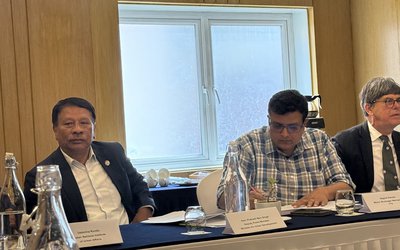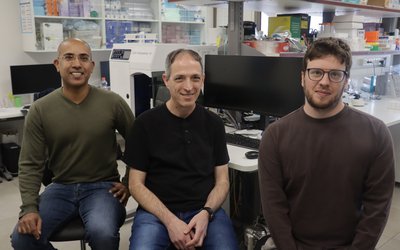Nepal International Film Festival 2024 (NIFF) has announced that the "Seventh Nepal International Film Festival" will be held from 1st Chaitra to 5th Chaitra at QFX Chhaya Center, Civil Mall, Labim Mall, QFX Bhaktapur, Nepal Tourism Board with the slogan "Celebration of stories from around the world". "
The 7th Nepal International Film Festival, which includes 88 films from 40 countries, is going to start from this Chaitra 1st. It is mentioned that 88 films from 40 countries have been selected from more than 500 films received from 60 countries in this festival organized by Nepal Film and Cultural Foundation.
The festival is divided into two parts, national and international. In both parts, 14 different awards will be presented in the categories of feature film, short film and documentary. It has also become public that the Gautam Buddha Award with 1500 US dollars will be awarded to the best feature film under international competition at the festival.
Similarly, it is said that one of the national and international feature films will be given the Don Quixote Award by the International Federation of Film Societies.
It is public knowledge that the films of the festival, which will run till 5th of Chaitra, will be screened in the halls under QFX. Nepali cinema, also known as "Kollywood", has been growing continuously for the past few years. This industry has been producing a significant number of films every year as the number of Nepali viewers in Nepal and abroad is increasing.
However, it is still a small industry, and the resources available are limited compared to the larger film industries around the world. The first movie made in Nepali language is Satya Harishchandra made in India, which was also dubbed in Nepali and released.
Also, the first screening of the movie made in Nepal was with Aama movie. The movie starred Shiv Shankar Manandhar and Bhuvan Chand, who is considered to be the first hero heroine of Nepali cinema. But before the production of this film made with government investment, Maitighar, which was made with private investment, was released only after Aama.
This movie has Mala Sinha and Chidambar Prasad Lohani (C.P. Lohani) in lead roles. The movie was directed by BS Thapa.
In 2027, the government established the Royal Nepal Film Institute and produced Manko Badh movie. Which was directed by Jai Rana and composed by Sangeet Natikaji and Shiv Shankar.
This was followed by Kumari in 2034 and Sindoor and Jeevan Rekha in 2036. With this success came the private sector in film production.
In 1978, a “Paraal ko aagao “(straw fire) was built. It was directed by Pratab Subba. The movie was a success because of the story and melodious music.
After 2036 B.S. many creative movies were made which were also successful. Due to this many construction companies came. Many movies were made. Samjhna, Kusume Rumal, Lahure, Kanchi, Vasudev, Saino and Kosheli are the best movies released from 1984 to 1993.
After the political change of 2046, the film sector also progressed, 140 films were produced in 3 years. The distribution of the film also started to increase. Cinema market expanded. Nepali producers succeeded in reducing the influence of Hindi films. Nepali actors have an important role in the development of Nepali movies. They are contributing to the industry by giving excellent performances, choosing challenging roles and promoting Nepali films at national and international levels. They have been using different genres and characters to widen the scope of Nepali movies while enhancing their acting skills.
There are many artists who have contributed to the development of Nepali cinema. They have played an important role in bringing attention to Nepali movies and creating a base for the industry.
Additionally, the rise of streaming platforms like Netflix and Amazon Prime have also opened up new opportunities for Nepali cinema. These platforms have made it possible for Nepali films to reach a global audience, which has helped increase the visibility and popularity of Nepali films.
In conclusion, Nepali cinema is still in the early stages of development, but with the continuous efforts of artists, directors and producers, this industry is gradually expanding and improving. The future of Nepali cinema looks bright, and with increased interest and investment in the industry, we can expect more quality films and talented actors to emerge in the coming years. Nepali film industry is an industry that produces films in Nepali language. Nepali film industry is centered in Kathmandu. Although the development process of movies in Nepal started a bit late, this sector is currently becoming stronger.
Dozens of movies are being produced in the Nepali cinema industry every year. Currently, the management and regulation of films in Nepal is done by the “Film Development Board”.
The Nepali film industry has gone through various stages and has entered the era of modern technology. Lately, Nepali movies have also started earning well.
The contribution of the film sector to Nepal's economy is also increasing. In Nepal, a large group of people are promoting the Nepali film industry by making movies their careers.
Although the history of Nepali cinema is relatively short, it has passed through various stages and reached its present state.
The Nepal Film Institute was established on 2028/7/16 and the Nepal Film Development Board was established in 2057.
Really love going to movies and festivals, getting as close as possible to see the best movies first and visit the talent. . So here is the list of festivals that can be named the biggest at this point:
Cannes Film Festival – It is still considered to be the largest film festival in the entire world. This is random, in order below.
Venice Film Festival Berlinale Toronto Sundance
For many of these reasons, constitute the Big-5. The only one of similar composition and artistic stature, which can be considered equally influential.
The main film festivals differ in terms of focus and selection criteria. Here is a brief overview:
- Cannes Film Festival: Held annually in Cannes, France, the Cannes Film Festival is one of the most prestigious and internationally recognized film festivals. It focuses on artistic and writer-driven cinema, screening a wide variety of films from around the world. Cannes is known for its red carpet premieres, glamorous atmosphere, and its main competition, the Palme d'Or, which is awarded for the best film.
- Sundance Film Festival: The Sundance Film Festival takes place in Park City, Utah and is the largest independent film festival in the United States. It primarily highlights independent and low-budget films, with a focus on discovering new talent and showcasing innovative storytelling. Sundance is renowned for supporting artistic expression and emerging filmmakers.
- Berlin International Film Festival: Berlin is one of the world's premier film festivals held every year in Berlin, Germany. It screens a wide range of films, including international premieres, arthouse cinema, and mainstream productions. The festival has a strong emphasis on political and social issues, and its highest award is the Golden Bear.
- Toronto International Film Festival: One of the world's largest publicly attended film festivals in Toronto, Canada. It screens a huge selection of films, including international premieres, documentaries, and high-profile Hollywood productions.
It is known for its audience-friendly approach and often serves as a platform to launch award season contestants.
- Venice Film Festival:
The Venice Film Festival held in Venice, Italy is the oldest film festival in the world. It focuses on a wide range of films, including art cinema, international productions, and genre films. The festival presents the prestigious Golden Lion Award for Best Film and celebrates both established and emerging filmmakers. 6. Tribeca Film Festival: Founded by Robert De Niro, the Tribeca Film Festival takes place in New York City and showcases a diverse selection of films, including independent features, documentaries, and shorts. It has a strong focus on supporting local filmmakers, community engagement, and innovative storytelling.
These are just a few examples, but each festival has its own distinct identity, selection process and thematic focus, catering to different aspects of the film industry and cinema appreciation.
Here is the SWOT analysis of Fantasy International Film Festival in Nepal:
Strengths:
- Cultural Heritage:
Nepal has a rich cultural heritage, which can be showcased through film festivals. It can attract filmmakers and cinephiles interested in exploring unique stories and traditions.
- Unique Locations: Nepal's stunning landscape and diverse locations can serve as attractive backdrops for movies, making it an attractive destination for filmmakers.
- Emerging film industry: Nepal's film industry is constantly growing, and international film festivals can provide a platform to promote and nurture local talent, encouraging the development of the industry.
- Tourism Potential: Hosting an international film festival can promote tourism in Nepal, attracting visitors interested in both the festival and the natural beauty of the country.
Weaknesses:
- Infrastructure: Nepal may face challenges related to infrastructure including venues, technical facilities and transportation to host an international film festival. Adequate infrastructure needs to be developed or improved.
- Limited International Exposure: Nepal's film industry may have limited international exposure compared to more established film industries. This may affect the festival's ability to attract well-known international filmmakers, actors and industry professionals.
Opportunities:
- Cultural exchange: International film festivals in Nepal can provide a platform for cultural exchange, promoting collaboration between Nepali filmmakers and their international counterparts. It can also introduce Nepali cinema and culture to the audience from all over the world.
- Tourism promotion: Film festival can contribute to promote Nepal's tourism industry as a film sector, attract more visitors and generate economic benefits.
- Industry Networking: Festivals can facilitate networking opportunities by allowing local filmmakers to learn from international professionals, explore co-production possibilities and access international markets. 4. Film Education and Workshops: The festival can organize film-related workshops, seminars and educational programs, providing valuable learning opportunities to aspiring filmmakers in Nepal.
Challenges:
- Competition: There are many established and well-known film festivals around the world, which can pose a challenge for the attention and participation of filmmakers and audiences.
- Funding: Organizing an international film festival requires significant financial resources. Raising sufficient funds can be a challenge, especially given the economic constraints of the local film industry and the country as a whole.
- Geopolitical factors: Political instability in the region, travel restrictions, or security concerns may affect the successful hosting of an international film festival in Nepal. It is important to note that this analysis is based on hypothetical assumptions and the specific context of Nepal.
The actual strengths, weaknesses, opportunities and threats of an international film festival in Nepal depend on various factors and require a more detailed analysis taking into account the specific circumstances and objectives of the festival.
The Nepali cinema industry, also known as "Kollywood", has its own distinct characteristics. Here are some general characteristics of the Nepali film industry:
Cultural identity: Nepali cinema often reflects the cultural traditions, values and lifestyle of the Nepalese people. It preserves and promotes the cultural identity of Nepal by portraying the local language, customs, festivals and social issues. Musical Elements: Music plays an important role in Nepali movies. Most Nepali films have many songs, including romantic songs, dance numbers, and folk-inspired tunes. These songs contribute to the storytelling and are often popularized as part of a movie's promotion. Variety of Genres: Nepali cinema covers a variety of genres including romantic dramas, social issue films, action thrillers, comedies and historical films. While romantic movies are very popular, there has been a growing trend to explore different genres and use storytelling techniques.
- Focus on emotional stories: Nepali movies often focus on emotional stories, highlighting relationships, family dynamics and human emotions. Love, friendship, sacrifice and social conflict are recurring themes in Nepali movies.
- Low budget production: Nepali film industry is mainly characterized by low budget production. Limited financial resources often affect the production value, technical aspects and visual effects of films. However, recently efforts are being made to increase investment and raise the level of production.
- Localization: Nepali cinema mainly caters to local audiences, and stories are set in a Nepali context. This localization helps connect with the audience on a cultural and emotional level and makes the films relatable to the Nepali audience.
- Growing International Recognition: While the Nepali film industry is facing challenges, the international recognition of Nepali films is increasing. Some Nepali films have been selected for international film festivals and have received acclaim, contributing to the visibility of the industry at the global level. The Nepali cinema industry is evolving and there is an increasing emphasis on improving production values, storytelling techniques, and exploring diverse narratives.
This industry is trying to adapt to the changing tastes of the audience and increase the overall quality of Nepali movies. Nepali film industry faces many problems.
Some of the main problems and their solutions can be as follows: Financial problem: Nepali film industry usually executes on short financial cost.
The financial crisis, including the limitation of production costs, affects film production. As a solution, the government can provide financial assistance to the Nepali film industry. Increasing foreign investment and collaborating with financial institutions can also be a solution.
- Market shortage: Nepali film industry faces market shortage. Problems in the entry, production and distribution of foreign films can prevent the distribution and screening of Nepali films. For the solution, Nepali films need to compete head-to-head in the market, use marketing and marketing strategies, and specialize in publicity and promotion. 3. Lack of new stories: Lack of stories and writing is also a problem in Nepali films. New, influential, and up-to-date stories could not be created due to the overabundance of domestic stories. One solution is to write new and latest stories on such problems and support them through authors. As support, film writers could be offered training, workshops, and writing prizes. 4. Piracy: Piracy is a significant problem for the Nepali film industry. Illegal DVDs and online piracy affect the source of income for movie producers. For solutions, measures such as hard legal proceedings, criminal commissions, and raising public awareness should be adopted.
- Foreign influence:
Foreign films have increased the competition in Nepali films. This affects the market of Nepali films and captures opportunities in screening and promoting Nepali films. For the solution, there is a specialty in protecting Nepali films in Nepali groups, training Nepali actors in acting and technical innovation, and screening Nepali films in international film festivals.
The government, filmmakers, artists, and the general public all need to make a concerted effort to solve Nepali film industry problems. Solving the problems requires positive action, policy making, training, etc.
Some of the steps taken by the Nepali film industry to reduce the influence of foreign films can be as follows: Showcasing the characteristics of Nepali films: Nepali films need to show their characteristics, culture, language, and democracy.
Nepali movies need to take Nepali language, local actors, local issues, and local stories into consideration. In this way, Nepali films can stand on their own merits and compete with foreign films separately.
Production of high quality films: Nepali films need to produce high quality films.
For this, there is a need to advance in the technical field, use advanced equipment, build special collections and train Nepali artists in acting and production. Support of famous Nepali actors in acting and production: Nepali film industry should support famous Nepali actors. The government needs to train Nepali artists in the field of production and acting, support them in acting and production. This means that if the quality of Nepali actors in acting and producing Nepali films is high, foreign films can have less impact on the Nepali film industry. By supporting the prominence and establishment of Nepali artists, Nepali cinema can develop self-reliance. Similarly, there may be ways in which the Nepali film industry can reduce the influence of foreign films. In recent times, the Nepali film industry has seen technological and literary improvements which may encourage it and reduce the influence of foreign films. Various countries provide many examples of how their film industry has reduced the influence of foreign films.
These examples can also provide guidance for the Nepali film industry. Nepali cinema has also shown excellent films. These films have succeeded in exhibiting excellence in story, production quality, acting, cinematography and social administration.
Here are some examples of great Nepali movies: “Kabaddi": This movie has become one of the most acclaimed and widely discussed Nepali films. It raises as a Nepali literary and cultural tradition. It contains information about love, the meaning of life, acceptance, and independence.
"Pashupati: This film captures the awesomeness and powerful atmosphere of the Pashupatinath Mela. It examines themes of Nepali culture, religion, dictatorship, politics, and adventure.
"Lootera": This movie is based on the story of a Victorian period in India and Nepal. It depicts tribal Nepalese culture, focusing on themes of love, trust, infidelity, and prestige. Kalo Pothi: This movie is based on the story of rural life in Nepal.
Many more films are there to be enlisted but due to space constraints , it is not possible to mention all , we apologize for that.
- “Kolahalko Kolaj “: A Collection Of Scattered Memories By Prakash Sayami
- Apr 02, 2025
- Nepal-India Trade, Transit And Unauthorized Trade: Some Considerations
- Jan 16, 2025
- PM Oli’s Forthcoming Visit To China: Will The Achievement Be Complete?
- Nov 29, 2024
- Obituary To Dr. Mohan Man Sainju!
- Nov 02, 2024
- Donations To Political Parties: Some Reflections
- Oct 24, 2024















